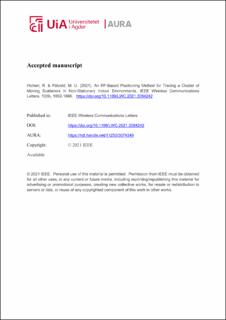| dc.contributor.author | Hicheri, Rym | |
| dc.contributor.author | Pätzold, Matthias Uwe | |
| dc.date.accessioned | 2023-06-29T11:32:26Z | |
| dc.date.available | 2023-06-29T11:32:26Z | |
| dc.date.created | 2021-07-23T15:19:34Z | |
| dc.date.issued | 2021 | |
| dc.identifier.citation | Hicheri, R. & Pätzold, M. U. (2021). An RF-Based Positioning Method for Tracing a Cluster of Moving Scatterers in Non-Stationary Indoor Environments. IEEE Wireless Communications Letters, 10(9), 1862-1866. | en_US |
| dc.identifier.issn | 2162-2345 | |
| dc.identifier.uri | https://hdl.handle.net/11250/3074349 | |
| dc.description | Author's accepted manuscript | en_US |
| dc.description | © 2021 IEEE. Personal use of this material is permitted. Permission from IEEE must be obtained for all other uses, in any current or future media, including reprinting/republishing this material for advertising or promotional purposes, creating new collective works, for resale or redistribution to servers or lists, or reuse of any copyrighted component of this work in other works. | |
| dc.description.abstract | This letter presents a novel iterative positioning method for tracing the body segments of a person moving indoors using radio-frequency (RF) signals. The indoor space is equipped with a multiple-input multiple-output (MIMO) communication system. The person is modelled by a cluster of moving point scatterers, playing the role of moving body segments. The proposed technique estimates the time-variant (TV) positions of the moving scatterers by fitting the TV channel transfer function (TVCTF) of the channel model as close as possible to the TVCTF of the measured channels. Numerical results are presented to demonstrate the accuracy of this method. | en_US |
| dc.language.iso | eng | en_US |
| dc.publisher | IEEE | en_US |
| dc.title | An RF-Based Positioning Method for Tracing a Cluster of Moving Scatterers in Non-Stationary Indoor Environments | en_US |
| dc.type | Peer reviewed | en_US |
| dc.type | Journal article | en_US |
| dc.description.version | acceptedVersion | en_US |
| dc.rights.holder | © 2021 IEEE | en_US |
| dc.subject.nsi | VDP::Teknologi: 500::Informasjons- og kommunikasjonsteknologi: 550 | en_US |
| dc.source.pagenumber | 1862-1866 | en_US |
| dc.source.volume | 10 | en_US |
| dc.source.journal | IEEE Wireless Communications Letters | en_US |
| dc.source.issue | 9 | en_US |
| dc.identifier.doi | https://doi.org/10.1109/LWC.2021.3084242 | |
| dc.identifier.cristin | 1922507 | |
| dc.relation.project | Norges forskningsråd: 261895/F20 | en_US |
| cristin.qualitycode | 1 | |
